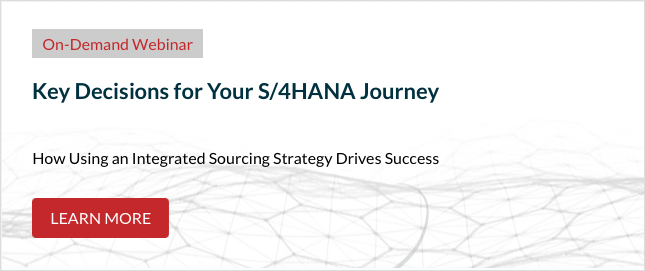- Devin Djerf
- Reading Time: 5 minutes

Customer engagement is no longer as simple as having a good product, an appealing website, and outstanding customer reviews. It is a well-known fact that customers engage with companies through multiple search cycles and may combine various channels to finally make a purchase.
Consider the buyer who searches on a laptop, then a cell phone, before making a purchase decision. They search over the course of several days or weeks via Google, product/service-specific review sites, etc. Any discontinuity in their personalized experience or lack of consistency from one channel to another (e-mail, mobile, social, SMS and the web) could break the fragile buying process. Omnichannel engagement leverages a multi-channel sales approach that provides the customer with an integrated and seamless shopping experience, so they feel the love before they make the buy.
SAP Acquires Emarsys
SAP announced the completion of the Emarsys acquisition on November 5th, but the terms of the transaction were not disclosed. It plans to integrate Emarsys into its SAP Customer Experience portfolio, which currently consists of Customer Data, Marketing, Commerce, Sales and Service Cloud offerings. Prior to the acquisition, Emarsys had raised $55.3M in two rounds of venture capital funding. This is an impressive funding endeavor that raised the eyebrows of software giant SAP.
Through its acquisition of 20-year-old Emarsys, SAP gets a best-of-breed omnichannel customer engagement platform which aims to accelerate business outcomes. Emarsys has over 1,500 customers where it delivers predicable and profitable outcomes comprised of a highly personalized omnichannel experience. The Emarsys platform enables customers to accelerate time to value, deliver superior one-to-one experiences and produce measurable results fast.
Some of Emarsys’ customers include Char-Broil, Samsonite, Gymshark, Tupperware, and Nike.
Why the Acquisition Matters
In an interview with Diginomica, Adrian Nash, Head of SAP’s Customer Experience, says it comes down to, “How SAP can apply its vast data to the pressing issues customers are facing. We think there’s a good opportunity for us to invest and grow based on the capabilities we have that are unique to SAP. We have an excellent foundation of data and customer data. I think we manage close to 3 billion first-party profiles in customer data, and over 7 billion consent transactions.”
Indeed, this puts a unique twist on why this acquisition makes sense.
But the biggest reason the acquisition matters is due to SAP’s plans to reach $26B in cloud sales by 2025. During the 3rd quarter alone, it added more than 500 S/4HANA customers, in which 45% were net new, taking its total customer base to more than 15,100. SAP’s third quarter revenues were down 4% at $7.7B, missing the market’s estimates of $8.2B, though cloud revenues grew 11% over the year, to $2.3B.
Emarsys is Just the Latest in SAP’s Acquisition Activity
SAP’s Customer Experience business unit is anchored by the Qualtrics platform, a key cog in SAP’s cloud growth strategy as it aims to meld customer data with operational data. But the company has spent a considerable $31B on acquisitions over the past decade. The 2018 acquisition of Qualtrics for $8B marked SAP’s serious interest in expanding Customer Experience, but the announcement of its intent to take Qualtrics public through an IPO raised some questions on just how committed it was to this part of the business.
SAP still owns a majority stake of Qualtrics, though, and when the Emarsys announcement came earlier this quarter, it was one of the factors that solidified its stance on Customer Experience. With acquisitions and IPO’s, there is obviously some uncertainty in SAP’s overall strategy and how this latest move fits into SAP’s overall C/4HANA product roadmap.
SAP plans to invest the next few years in consolidating the various acquisitions it has made in the past decade. While the additions have added capabilities to its portfolio, it does not have a strong track record for integrating these acquisitions well. In the next few years, it plans to fix that to help deliver an improved Customer Experience. SAP is still working on integrating their marketing solutions fully into its cloud, and while the Emarsys acquisition adds to that issue, it is known as a best-of-breed solution for personalization – a quality that’s increasingly important when needing to provide a compelling customer journey.
Going Forward
With COVID-19 still an ongoing concern with no clear end in sight, SAP is even more focused on Customer Experience, given that customers will be heavily reliant on shopping online rather than in person. Aside from the obvious implications for its retail customers, the new Customer Experience will have a large impact on all ecommerce industries, including entertainment, electronics, and automotive.
As with any acquisition, SAP needs to report to Wall Street that customers are buying into their vision and adoption is high. They at least want to report out on the number of customers who have adopted the solution, even if the dollars tied to those adoptions aren’t materially contributing to cloud targets. As a result, SAP will be pushing for customers to at least include some elements of Customer Experience in their cloud deals.
Key Customer Considerations
Any customers making investments in related cloud solutions like C/4HANA can anticipate SAP positioning inclusion of this in the bill of materials. With SAP getting the ability to report out that you are another customer who bought into their vision, they will be more willing to sweeten your full cloud deal.
If you are considering becoming or already are an Emarsys customer or a C/4HANA customer, there are three questions that should be top of mind:
1. How much control will I have regarding my existing Emarsys agreement?
If you are an Emarsys customer whose agreement predates the SAP acquisition, odds are that your terms vary from SAP’s standard terms which may be in your favor. It will be important to get an understanding of those variances and determine what leverage or flexibility you have (or don’t have) to prepare for a future state where your Emarsys software will be owned by a separate legal entity.
2. If I am considering a major investment in Emarsys or the C/4HANA suite, should I buy now or wait until the C/4HANA strategy evolves further?
Understanding SAP’s business practices and how to generate leverage is an important part of how to answer this question. Customers will need to understand how SAP licenses Emarsys within the suite and also how to maximize any current spend opportunity to drive the best cost structure. In addition, customers will also need to drive the most competitive commercial terms and obtain clarity from SAP contractually on how (to the extent possible) to establish predictability today, rather than be subject to future uncertainty based on how the software and contract assets are treated after they are wound into C/4HANA.
3. How does all of this fit into my plans to migrate from ECC to S/4HANA generally and C/4HANA specifically?
This announcement certainly clouds the picture SAP has been trying to paint regarding its strategy and product roadmap to move customers from ECC on-prem to S/4HANA in the cloud and especially C/4HANA given the Qualtrics spinoff. Understanding the frameworks, commercially and contractually, of how other customers are addressing their migration is imperative. An informed customer can therefore proactively seek for SAP to provide a path which drives clarity and predictability not only for S/4 but also C/4 and Emarsys, thereby reducing risk and improving visibility on navigating this critical step in your SAP relationship.
Comment below, follow me on Twitter @dcdjerf , find my other UpperEdge blogs and follow UpperEdge on Twitter and LinkedIn. Learn more about our SAP Commercial Advisory Services.

